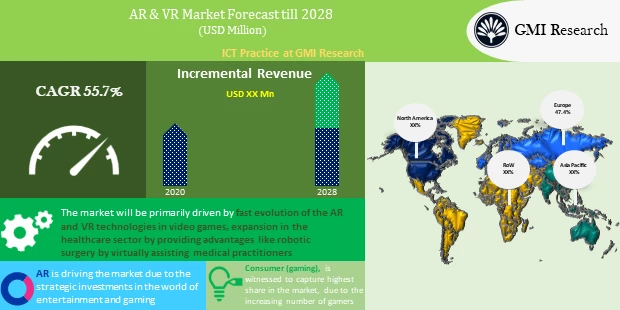No products in the cart.
Press Release
As per the GMI Research forecasts, the major factors fuelling the growth of the augmented reality and virtual reality market are rising penetration of 5G, increasing number of mobile gamers, increasing number of internet and smartphone users. The market was estimated to be USD 22,500 million in 2020, while growing at a CAGR of 55.7% during the forecast period (2021-2028).
The global AR & VR market is likely to experience a significant surge, with the growing number of smartphone users and mobile gamers across the globe. For instance, a report published by Gamespot in 2020 states that total spending on video games in the US during the Q2 of 2020 reached nearly USD 1 billion, almost 50% more than Q2 of 2019, recorded as the highest spend in the history since 2008. For many consumers, immersion is a significant factor in their enjoyment of games, movies, TV series, and more, which has led to the adoption of VR devices.
To have an edge over the competition by knowing the market dynamics and current trends of “Augmented Reality (AR) and Virtual Reality (VR) Market”, request for Sample Report here
During the COVID-19 pandemic, the healthcare AR/VR applications gained pace due to general recognition in telemedicine, medical education & training, and patient care management. Also, virtual & augmented reality in healthcare was inspired significantly, which led to significant technological advancements in the available room of the market. For instance, in 2020, XRHealth provided an application by receiving USD 7 million to extend its telehealth platform. Technologies can improve self-diagnostics, especially in remote areas where visiting clinics is challenging, and people tend to use telehealth services instead. Moreover, the market is poised to grow exponentially during the pandemic owing to AR/VR technology used to efficiently manage the treatment schedules, treatment delivery, and plans, thereby positively affecting the market to a certain extent.
Based on application, consumer gaming holed the major pie of the market and is likely to sustain the dominancy in the market over the forecast period. The increase in number of gamers and the increase in average minutes of gaming per day after 2017, has increased significantly. For instance, OFCOM: Media Nations Report 2020 states that, the average gaming time has increased from 2017 to 2020 by 9 minutes, which has driven the overall market growth.
Key Developments:
- In 2021, Samsung launched its AR app for galaxy user’s smartphones. However, it is compatible with most of its smartphones including, S21, S21 ultra, S20 ultra, A51, A71, among others. This application allows users to use tools and text brushes to crate AR objects using a camera viewfinder.
- In 2020, Facebook launched VR remote work app, calling it a step to the ‘metaverse, where users of the company’s Oculus Quest 2 headsets can hold meetings as avatar versions of themselves. The beta test of Facebook’s Horizon Workrooms app comes as many companies continue to work from home after the Covid-19 pandemic shut down physical workspaces.
The global AR & VR market is segmented into type, offering, and application. Based on the type, the market has been segmented into AR and VR. Based on the offering, the market has been segmented into software and hardware. Based on application, the market is segmented into consumer (gaming), consumer (video), retail & marketing, transportation & automotive, education, manufacturing & CPG, healthcare, government, others (enterprise, utilities & energy).

